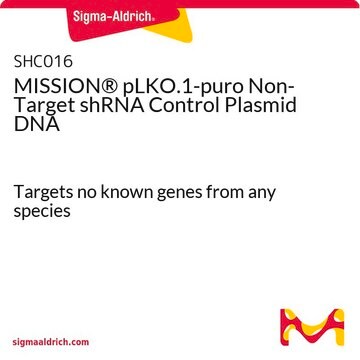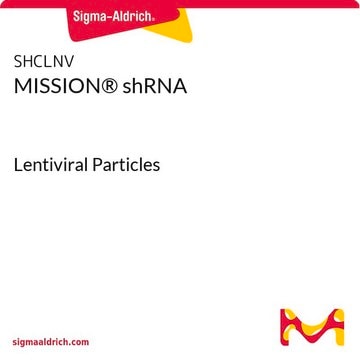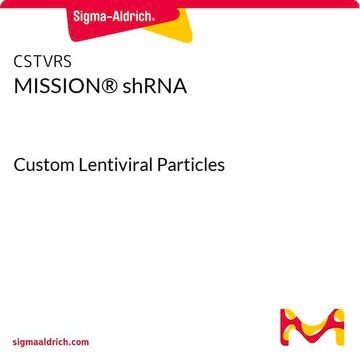No. The cloning site, EcoR1, is ablated during production to prevent cloning into the vector. Please see the link below to review the product datasheet:
https://www.sigmaaldrich.com/deepweb/assets/sigmaaldrich/product/documents/396/419/shc003bul.pdf
SHC003
MISSION® pLKO.1-puro-CMV-TurboGFP™ Positive Control Plasmid DNA
Green fluorescent protein marker to monitor transduction efficiency
Synonym(s):
MISSION® Control Vectors
Select a Size
Select a Size
About This Item
Recommended Products
Quality Level
product line
MISSION®
concentration
500 ng/μL in TE buffer; DNA (10μg of plasmid DNA)
shipped in
dry ice
storage temp.
−20°C
Looking for similar products? Visit Product Comparison Guide
General description
Ampicillin and puromycin antibiotic resistance genes provide selection in bacterial or mammalian cells respectively. In addition, self-inactivating replication incompetent viral particles can be produced in packaging cells (HEK293T) by co-transfection with compatible packaging plasmids. The TurboGFP Control Vector is provided as 10 μg of plasmid DNA in Tris-EDTA (TE) buffer at a concentration of 500 ng/μl.
Application
Legal Information
recommended
Storage Class
12 - Non Combustible Liquids
wgk_germany
WGK 1
flash_point_f
Not applicable
flash_point_c
Not applicable
Choose from one of the most recent versions:
Certificates of Analysis (COA)
Sorry, we don't have COAs for this product available online at this time.
If you need assistance, please contact Customer Support.
Already Own This Product?
Find documentation for the products that you have recently purchased in the Document Library.
Customers Also Viewed
Articles
When shRNA is delivered using lentiviral vectors, the sequence encoding the shRNA is integrated into the genome and the knockdown effect is passed on to daughter cells, continuing gene silencing.
-
dear officer I'd like to know if I'm able to clone in shRNA of choice downstream of the U6 promoter of this plasmid (SHC003)? is there any RE site available to do so? Thank you
1 answer-
Helpful?
-
-
Can I purchase lentiviral particles produced using MISSION® Control Vector Purified DNA TurboGFP™ plasmid, Product SHC003, directly from Sigma-Aldrich?
1 answer-
Yes. The product code is SHC003V.
Helpful?
-
-
What competent cells can I use to propagate the MISSION® Control Vector Purified DNA TurboGFP™ plasmid, Product SHC003?
1 answer-
We use GC5 cells (identical genotype to DH5α-T1R) to propagate the Mission shRNA plasmids and controls.
Helpful?
-
-
How much plasmid DNA do I receive when I order MISSION® Control Vector Purified DNA TurboGFP™, Product SHC003?
1 answer-
Each MISSION Control Vector is provided as 10 μg purified plasmid DNA at a concentration of ~500 ng/μL in 10 mM Tris-HCl, pH 8.0, containing 1 mM EDTA.
Helpful?
-
-
Can I use MISSION® Control Vector Purified DNA TurboGFP™ plasmid, Product SHC003, to produce lentiviral particles?
1 answer-
The MISSION® Lentiviral Packaging Mix can be used if you wish to produce virus in your own lab. The product code is SHP001. This product is an optimized formulation of two plasmids expressing the key HIV packaging genes and a heterologous viral envelope gene. The Lentiviral Packaging Mix is designed to be co-transfected along with a compatible lentiviral transfer vector (such as SHC003) into HEK293T cells in order to create high-titer pseudo-typed lentiviral particles used for downstream transduction applications. The procedure is available in the Technical Bulletin for product SHP001.
Helpful?
-
-
What is the Department of Transportation shipping information for this product?
1 answer-
Transportation information can be found in Section 14 of the product's (M)SDS.To access the shipping information for this material, use the link on the product detail page for the product.
Helpful?
-
Active Filters
Our team of scientists has experience in all areas of research including Life Science, Material Science, Chemical Synthesis, Chromatography, Analytical and many others.
Contact Technical Service











